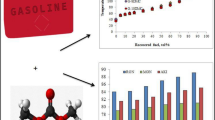Abstract
A detail investigation of the combustion behavior of a representative ester-alkane blended fuel was conducted with the aim to get better knowledge of the fire hazard of the blended fuels. Experiments have been carried out in a cone calorimeter with ISO 5660 standard procedures. The blended fuel is burned in a fuel pan with 80 mm in diameter and 20 mm in lip, and the initial fuel volume is 20 mL. The hazard parameters such as heat release rate, effective combustion heat, combustion yield, and combustion efficiency were studied using a cone calorimeter. The actual combustion reaction equation of dimethyl carbonate (DMC)/n-heptane blends was calculated, and the thermal chemistry method based on the stoichiometry of reaction equation is adopted to evaluate the oxygen consumption method for the DMC/n-heptane blends. A formula is put forward to describe the burning rate of respective component in the blends during burning process, and the burning rate of DMC in the blends is steady during the test. The CO yield, carbon conversion ratio, and energy conversion efficiency data of the blends are calculated and compared, the result shows that the carbon conversion is close to the energy conversion, and this means that soot yield is the major contributor to incomplete combustion of blends.








Similar content being viewed by others
References
Ren Y, et al. Combustion and emissions of a DI diesel engine fuelled with diesel-oxygenate blends. Fuel. 2008;87(12):2691–7.
Liu H, Hu B, Jin C. Effects of different alcohols additives on solubility of hydrous ethanol/diesel fuel blends. Fuel. 2016;184:440–8.
Wilson GR, et al. Certification of alternative aviation fuels and blend components. Energy Fuels. 2013;27(2):962–6.
Ding Y, et al. The effect of azeotropic blended fuel on combustion characteristics in a ceiling vented compartment. Fuel. 2017;189:1–7.
Chen G, et al. Experimental and modeling study of the effects of adding oxygenated fuels to premixed n-heptane flames. Combust Flame. 2012;159(7):2324–35.
Chen Q, et al. Fire hazard analysis of alcohol aqueous solution and Chinese liquor based on flash point. IOP Conf Ser Mater Sci Eng. 2017;241:012036.
Chen Q, et al. Investigation on the fire hazard characteristics of ethanol–water mixture and Chinese liquor by a cone calorimeter. J Therm Anal Calorim. 2018;135:2297–308.
Li D, et al. Effects of dimethyl or diethyl carbonate as an additive on volatility and flash point of an aviation fuel. J Hazard Mater. 2009;161(2–3):1193–201.
Ding Y, Wang C, Lu S. The effect of azeotropism on combustion characteristics of blended fuel pool fire. J Hazard Mater. 2014;271:82–8.
Liu H, et al. The effect of mixture ratio on combustion characteristics of n-propyl alcohol–water binary mixture. J Therm Anal Calorim. 2018;134:2255–64.
Wang X, et al. Experimental study on fire behaviors of kerosene/additive blends. Fire Technol. 2018;54:1–29.
Wang X, et al. In-depth analysis of burning process of binary blended fuel pool fires based on liquid–vapor equilibria. Fuel. 2019;256:115918.
Wang X, et al. Experimental study on combustion characteristics of blended fuel pool fires. J Fire Sci. 2019;37:236–56.
Bae JH, Avedisian CT. Experimental study of the combustion dynamics of jet fuel droplets with additives in the absence of convection. Combust Flame. 2004;137(1–2):148–62.
Imtenan S, et al. Impact of oxygenated additives to palm and jatropha biodiesel blends in the context of performance and emissions characteristics of a light-duty diesel engine. Energy Convers Manag. 2014;83:149–58.
Xu Y, Avedisian CT. Combustion of n-butanol, gasoline, and n-butanol/gasoline mixture droplets. Energy Fuels. 2015;29(5):3467–75.
Westbrook CK, et al. A comprehensive detailed chemical kinetic reaction mechanism for combustion of n-alkane hydrocarbons from n-octane to n-hexadecane. Combust Flame. 2009;156(1):181–99.
McEnally CS, Ciuparu DM, Pfefferle LD. Experimental study of fuel decomposition and hydrocarbon growth processes for practical fuel components: heptanes. Combust Flame. 2003;134(4):339–53.
Glaude PA, Pitz WJ, Thomson MJ. Chemical kinetic modeling of dimethyl carbonate in an opposed-flow diffusion flame. Proc Combust Inst. 2005;30(1):1111–8.
Zhang W, et al. Combustion calorimetry of carbonate electrolytes used in lithium ion batteries. J Fire Sci. 2014;33(1):22–36.
Liu J, et al. Impacts of ceiling height on the combustion behaviors of pool fires beneath a ceiling. J Therm Anal Calorim. 2016;126:881–9.
Eshetu GG, et al. In-depth safety-focused analysis of solvents used in electrolytes for large scale lithium ion batteries. Phys Chem Chem Phys. 2013;15(23):9145–55.
Acknowledgements
This work was supported by National Key Research and Development Program of China (No. 2018YFC0809500) and National Natural Science Foundation of China (No. 51706218).
Author information
Authors and Affiliations
Corresponding author
Additional information
Publisher's Note
Springer Nature remains neutral with regard to jurisdictional claims in published maps and institutional affiliations.
Rights and permissions
About this article
Cite this article
Wang, X., Wang, W., Chen, Q. et al. Experimental study on combustion and yield characteristics of dimethyl carbonate/n-heptane blends in the cone calorimeter. J Therm Anal Calorim 143, 3057–3064 (2021). https://doi.org/10.1007/s10973-020-09455-8
Received:
Accepted:
Published:
Issue Date:
DOI: https://doi.org/10.1007/s10973-020-09455-8




